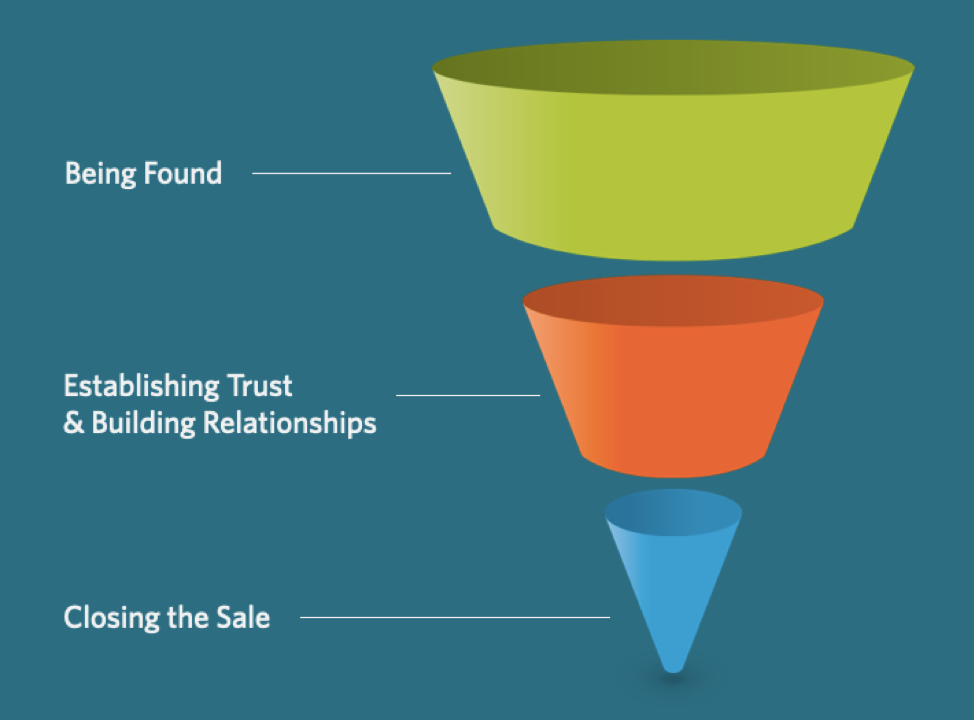Business leaders all across the professional services world are waking up to an indisputable truth: Your firm’s website matters more than ever.
But the role our websites play in our marketing and business development efforts continue to evolve. What worked five years ago to separate your firm from your competitors may not work today.
At Hinge, we audit hundreds of professional services websites a year. In this article, we’ll explore 21 traits of poorly designed professional services websites that we see on a regular basis. I provide links to relevant resources under each point.
Planning and Organizational Issues
Poor design usually happens long before a single page has been published online. Whether it was a broken planning process or some other dysfunction, there are many planning and organizational issues that make it more difficult for marketers to keep their websites purring like well-oiled business development and marketing machines. Let’s explore some of these issues.
1. Leadership misunderstands the value of a great website
While more and more firms are beginning to recognize the value that a high performing website could bring to their business, there are still some laggards who need convincing. Websites that are built with low investment will likely become outdated rapidly.
If your leadership team is still in need of some convincing, consider these facts from the Hinge Research Institute.
- Today’s buyers are looking online for insights 66% more often than they did 5 years ago
- 72% of buyers use digital channels to evaluate service providers
- 90% of buyers will rule out a firm before even talking with them
- Each year, professional services firms generate more leads online than they did the previous year
The days of your website being an online brochure are over. Professional services marketers must continue to make the case to their leadership teams that it is time to invest in a more sophisticated website. Check out Hinge’s Lead Generating Website Guide for a compelling look at what a professional services website should be.
2. Inconsistent strategy and metrics applied to the website
As your marketing plans evolve, so too should your website. One sign of a poorly designed website is when it is clear to users that the website has not been kept in alignment with the firm’s overall strategy. There are dozens of examples of this, including blogs or news sections that haven’t been updated in months, outdated event pages, and broken links.
Your website is supposed to be your perfect marketing partner—silently making the case to your prospects that you have the solutions they need. If neglected by your internal team, your website will soon begin to tell an unhelpful story. Internal marketing teams need to review their website’s content and goals on a regular basis… ensuring that the site is aligned with the firm’s overall business strategy.
In this article you can learn about some top B2B website metrics you should be tracking.
3. Inefficient process for engaging subject matter experts for content
Most firms are aware of the benefits of publishing high-quality and accessible content on their websites. In fact, content creation was listed as the number one marketing priority of professional services firms in our 2022 High Growth Study. Creating quality content is no walk in the park though! And many professional services marketers struggle to engage their firm’s subject matter experts (SME’s) — the very people your prospects want to hear from.
Have you ever noticed a firm’s blog that hasn’t been updated in months? This is an indication that their process for creating content is not working efficiently. Either the process is broken, their SMEs are not invested in the content creation strategy, or content creation is not a priority at that firm.
A high-performing website needs fresh content. For some tips, check out this article on the importance of a content calendar.
4. The website is too hard to update
You are a marketer, not a website developer. You don’t want to rely on a third party developer to make all your website updates for you. Your website has to be an accessible resource which you and other members of your team can update with ease.
But not all websites are created with you in mind. If you find yourself held hostage by a system that makes updates hard, consider redesigning your website on a friendlier content management system.
Read this article for more insight on B2B Website Strategy and what your content management system should enable you to do.
5. Form is hindering function
Of course, we all want our websites to look modern and fresh — and represent the qualities of our brand. Just make sure your cutting-edge design doesn’t hinder the user experience.
Distracting videos and intricate animations can overwhelm the main message. “Clever” navigation can be difficult to find or use. Don’t forget! You have only a few seconds to make a good impression for your website visitors. We don’t want them to get lost from the start.
Now let’s be clear! Your website doesn’t have to be plain or unoriginal. But good design isn’t just about good looks. It is easy for users to navigate and delivers your message with exceptional clarity (here’s just one example).
Top of the Funnel Website Issues
Your website should play a role at each stage of the marketing funnel. At the top of the funnel, your goal is to be found by users searching for your services. In the middle of the funnel, your website delivers the educational content (blog posts, webinars, guides, etc.) that build a loyal audience over time and keep your firm top of mind. And at the tip of the funnel, your website provides the case stories and hard offers (like free consultations or demos) that help seal the deal. How do we ensure that our websites are built to accomplish these goals?
In this section we’ll explore some traits of poorly designed websites that affect the top of the funnel goals. We’ll look at the middle and bottom of the funnel a bit later.

6. No SEO strategy
Search engine optimization (SEO) is the practice of enhancing your website to help its content be found in Google and other search engines. According to our 2022 High Growth Study, only 21.9% of high growth firms report that they plan to prioritize any kind of SEO activity as part of their marketing strategy this year. This means that there is an opportunity to outmaneuver many of your competitors by investing in some basic SEO.
While it’s a good idea to optimize the main pages of your website for specific keywords, the competition for the best industry keywords can be stiff. An even more fruitful strategy is to develop searchable, keyword-optimized educational content, such as blog posts, that make your expertise more visible to prospective clients who are seeking information on the kinds of problems your firm solves. When your ideal prospect is looking for an answer, what do you want them to find? Your website. Invest in keyword research and watch your traffic climb.
Want to learn more about SEO? Check out Hinge’s SEO Guide for Professional Services.
7. No functional support for SEO
We know that Google favors sites that load quickly. Search engine optimization rules like this are always evolving. Savvy firms have a technology or marketing partner who keeps up with the changes and makes any needed structural changes to their site.
One way we think about our website strategy is the rhythm of testing, measuring, and learning. To stay on top of the pesky search engine algorithms, you need to always be testing new things on your website with the intention of improving your results. Without functional support for SEO and website optimization, your website will begin to fall behind today’s high standards.
Have questions about outsourcing parts of your marketing team? Check out this blog post breaking down some options.
8. Not mobile friendly
You may imagine that most of your buyers are sitting in front of their laptops when they search around on your site, but there’s at least a 50% chance that isn’t true. According to Statista, approximately half of worldwide internet traffic was on a mobile device in 2019.
Most websites that have been redeveloped within the last 5 years employ responsive design and are mobile friendly. From time to time though, I come across older professional services sites that fail on mobile platforms. To find out if your website is mobile friendly, take Google’s mobile friendly test.
9. Poor content organization
How your website is organized plays a huge role in keeping users on your website and making it easy to find the information they need. Websites can become bloated or disorganized over time. If your users are not finding the information they are looking for, then they will quickly leave your website. Every three to five years, you should take a hard look at your website’s content and do some pruning and tidying.
Check out this overview of information architecture from Amelia to learn the core principles you should follow.
10. Mixing company news and thought leadership
Speaking of content organization, one easy way to confuse your website visitors and dilute your expertise is to mix your company announcements with your thought leadership pieces. It’s great that your firm is celebrating two new hires this month… but that announcement should not be made in the section of your website you are using to educate clients and prospects. Dedicate a separate page or section for your company news.
Continue exploring Hinge’s website and observe how we keep our news and events separate from our library section.
11. Poor content quality
Let’s not beat around the bush. Bad content is not going to be picked up by search engines and will discourage people from returning to your website again. To be found in a noisy digital environment, you need to stand out with high-quality content.
At Hinge, we recommend that you leverage the power of research to improve the quality of your content. For more information on using research to supercharge your content strategy, read Hinge’s free guide Research as Content: A Guide for B2B Marketers.
12) No automated filtering features
Automated filtering features make easy to selectively organize and find information. In fact, filters give your web visitors the power to quickly and easily sift through hundreds or thousands of possible results. Don’t let your visitors become exhausted looking for the right content. Provide them with tools to make their experience a breeze. If you have a large amount of information (such as blog posts or case studies) in a section of your website, filtering can be a huge useability boon for your visitors.
For an example, see how Hinge’s website allows users to sort case stories based on the different industries we serve.

13. Visibility metrics go untracked
If the one of the main goals of your website is to increase your firm’s visibility, then it’s vital that you have a grip on its performance. Consider setting up a dashboard where you track key metrics on a weekly or monthly basis.
What should you track? Here are a few ideas to get you started:
- Organic search traffic
- Total website traffic
- Total form fills or conversions
- Inbound leads
- Top performing pages
Three of these metrics are already available to you in Google Analytics. Tracking conversions requires a bit of setup, but is a snap to see and use once you’ve done the up-front work.
Ignorance might be bliss in some aspects of life, but not when it comes to improving the reach of your website. Tracking is an essential part of maintaining a strong professional services website. Read more about the top B2B website metrics you should be tracking here.
Middle of the Funnel Website Issues
In the middle of your marketing funnel, you want your website to establish credibility with your users. Do you know what you’re talking about? Can your firm solve the problems your web visitors are looking for? This is the stage where prospects are evaluating you as a service provider. Here are the qualities of poorly designed websites for the middle of the funnel:
14. Outdated imagery or style
Have you ever had the experience of visiting a website and immediately hitting the back button once the page loaded? Of course you have! And most of the time I find myself doing this because the website had such an outdated and cheesy look that my brain subconsciously decided that I could find what I was looking for elsewhere.
The overall aesthetic of your website matters. If your website looks like your competitors’, if you are using tired stock photos of chess boards, puzzle pieces and boardrooms, or if your site simply lacks sophistication, your firm’s credibility is probably suffering. Otherwise rational people make snap decisions based on visual cues.
If your website’s design is looking out of date, then it might be time to consider building a new one. Here’s an example of a growing government IT contractor who rebranded and designed a new website that aligned more with the company’s ambitious culture.
15. Weak team member profiles
One question we receive all the time is this: “If we feature our experts on our website, won’t that make it easier for recruiters or other firms to poach them?” We understand. Recruiting top talent is a challenge and the last thing anyone wants is to lose their key team members. But Hinge is of the belief that you have more to gain than lose from featuring your experts.
Think again about the role your website plays in the middle of the marketing funnel. You are attempting to establish trust and credibility with an audience who likely hasn’t reached out to you yet. In professional services, the expertise of your people is the key to your credibility.
By featuring your experts, their credentials and the content they’ve written, you not only support your claims of expertise, but you add life to your website. Professional services are people businesses. It is a mistake to keep them hidden.
See an example of how Hinge features their team members here.
16. No cross-linking between team members and content
Speaking of your experts, hopefully they are contributing to the content strategy on your website. A big mistake we see is when firms produce great content and build great expert bio pages but then don’t take the extra step of cross-linking them. You want your prospects to get to know your experts. When they draw clearer connections on your website between the experts and the content they’ve written, you’ll only benefit.
See again here an example of how Hinge cross-links our expert profiles with the content they’ve written recently.
17. No connection between website and CRM/automation tools
Each year, more firms use marketing automation tools. But not all firms have successfully integrated this technology into their website.
A high performing professional services website does more than describe a firm’s services. As users come to your website, there ought to be opportunities for them to connect and engage with you. Perhaps you host regular webinars? Or maybe you’ve written a whitepaper of particular interest to a large swath of your audience? Whatever it is, there should be mechanisms built into your website where visitors can access your expertise. And when they do, your marketing automation system is there to collect their contact information and start nurturing them.
You can read more on marketing automation strategies here.
Bottom of the Funnel Website Issues
We finally arrive at the bottom of the marketing funnel, where your website plays a critical role. Your website is not only one of the primary ways prospects get in touch with you, but it is a resource they will refer back to as they make their final decision. Your website’s design, messaging and content must send the message that your firm is the right choice. Here are some bottom-of-the-funnel mistakes professional services firms make on their website.
18. Incomplete case stories
Powerful case stories on your website can attract new prospects, establish the credibility of your firm, highlight your expertise and help you close more business. But unfortunately, this is another area where many websites fall flat. Overly brief case stories are unlikely to provide sufficient detail to persuade anyone.
Instead, your case stories should pop – each with their own unique message about how you solved a critical problem for a client. Videos, photos, testimonial quotes, listed key accomplishments and specific results or metrics can bring case stories to life. Each case story should be hosted on its own individual page on your website.
Want advice on writing better case stories? Read this helpful article featuring 10 tips for writing case stories here.
19. Suboptimal landing pages
Landing pages should be powerful persuaders. If you are offering a free consultation, a gated piece of premium content, or access to an online event, you likely will use a landing page as your channel for driving conversions. Many landing pages, however, are not great.
Common pitfalls of poorly designed landing pages include super-long forms that users might hesitate to fill out, extra navigation options that distract from the landing page’s main goal, and messaging doesn’t drive the viewer to take the desired action.
Check out this video on creating better landing pages:
Error! You must specify a value for the Video ID, Width, Height parameters to use this shortcode!
20. Poorly conceived call-to-action strategy
Poorly designed professional services websites make one of two mistakes: 1) not asking the visitor to take a next action; or 2) having too many many different asks that compete for a user’s attention.
In the first case, many firms will only provide a “Contact Us” button in their main navigation. There’s nothing wrong with this navigation option… but is that it? What else can your website offer besides a way to get in touch with you? Maybe you could write a guide on a topic that interests your audience. In the second case, firms that pack their pages with forms and offers can have disappointing results. At the end of the day, your call-to-action strategy should be crystal clear for each part of your website.
Are calls to action more of a science or art? Reference this article for more information on making the most out of your call to action strategy.
21. No or very few offers for more engagement
Finally, some poorly designed websites will not feature any offers for further engagement. What if you asked them to contact you for a free consultation? Or perhaps a demonstration of your product in action? Professional services websites that have specific, relevant offers outperform their peers.
Check out Hinge’s Marketing Planning Guide for more information on planning your marketing initiatives to drive engagement.
A Final Mistake
Poorly designed professional services websites come in many shapes and sizes. If your website isn’t getting the job done, you don’t have to settle. Identify where in the marketing funnel your website is lacking and begin making adjustments. And if you don’t have the time or skills to handle it in-house, reach out to a qualified partner who understands your business to help you out. The final mistake you could make is to do nothing.
How Hinge Can Help
Your website should be one of your firm’s greatest assets. Our High Performance Website Program helps firms drive online engagement and leads through valuable content. Hinge can create the right website strategy and design to take your firm to the next level.
Additional Resources
- Our Lead Generating Website Guide details how your firm can generate qualified leads with its website.
- And our free Lead Nurturing Guide will show you how to nurture those leads through the sales cycle.
- Hinge University offers a wealth of tools and information to make your website more powerful and persuasive.




